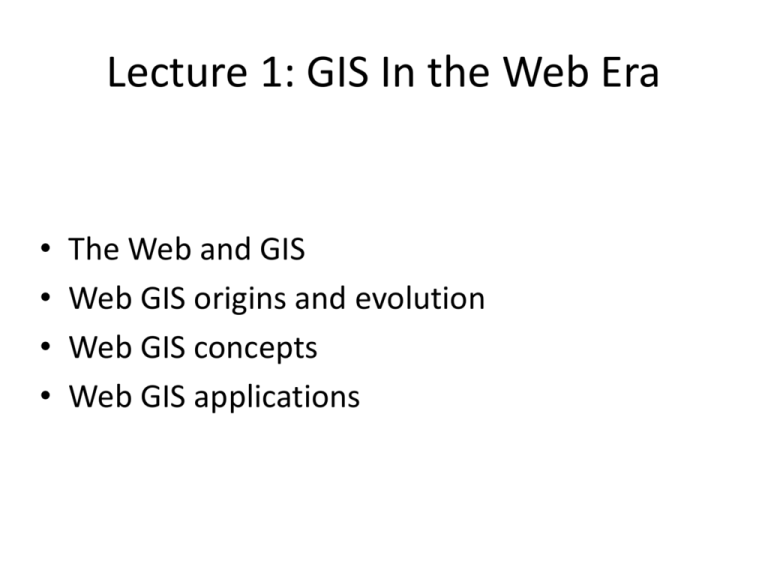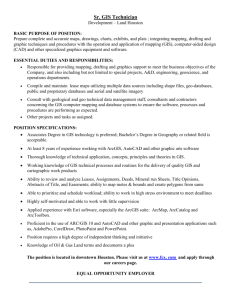Characteristics of Web GIS
advertisement

Lecture 1: GIS In the Web Era • • • • The Web and GIS Web GIS origins and evolution Web GIS concepts Web GIS applications The Web and GIS The Internet, the Web, and the mobile Web • • • • Birth of the Internet: ARPANet --When ARPANET connected UCLA to Stanford, UC Santa Barbara, and the University of Utah, there were three things that users could do: log into a remote computer, print to a remote printer, and transfer files between computers. As ARPANET aged, it grew at a steady pace, constantly connecting more computers and institutions, and adding new technologies along the way. In 1983, ARPANET converted its old NCP( Network Control Protocol) to the newer and more universal TCP/IP. This created what is known today as the Internet, since it allowed different networks (ARPANET, NSFNET, CSNET, BITNET) to be interconnected. The TCP/IP protocol is still used today. The Internet did not gain popularity until 1990s. Before then, main services were e-mail, Usenet News, file transfer, and Telnet. Complex to use, mainly for professionals. In 1990, Tim-Berners-Lee (“father of the Web”) at CERN (European Org. for Nuclear Research) invented HTTP (Hypertext Transfer Protocol), HTML (Hypertext Markup Language), and the URL (Uniform Resource Locator). He developed the first Web server and a Web browser, naming his invention the World Wide Web. • Internet: a massive network of networks that connects millions of computers worldwide using a number of protocols: HTTP, SMTP (Simple Mail Transfer Protocol), FTP, IRC(Internet Relay Chat), IM (instant messaging), Telnet, and P2P(peer-to-peer). • World Wide Web(WWW): a system of interconnected hypertext documents and programs that can be accessed via the Internet primarily by using HTTP. • The Web is still quickly expanding, from wired into wireless (mobile Web). GIS • GIS is a system of computer hardware, software, and procedures that capture, store, edit, manipulate, analyze, and visualize geo-referenced data. • The first operational GIS (Canada G.I.S.- CGIS) was developed in 1962 by Roger Tomlinson (“father of GIS”) for land inventory and planning. • GIS capabilities go beyond mapping. GIS offers a rich set of analytical functions. • The emergence of Web GIS is unlocking the power of GIS to a wider audience. Web GIS Origins and Evolution Early Web GIS • In 1993, the Xerox Corporation Palo Alto Research Center (PARC) developed a web-based map viewer, marking the origin of Web GIS. Users could use the map viewer in a web browser and click a link to a function. The browser sends an HTTP request to the web server, the server receives the request, performs mapping operations, generates a new map, and returns it to the browser. The browser displays the map as a map image. • Early Web GIS examples: - 1994, Canadian National Atlas Information Service - 1995, Alexandria Digital Library - 1995, National Geospatial Data Clearinghouse (by USGS) - 1995, U.S. Census TIGER Mapping Service - 1996, Mapquest. Web GIS in the Web 2.0 • Web 2.0 was coined in 1999 to describe web sites that use technology beyond the static pages of earlier web sites. It is closely associated with Tim O'Reilly because of the O'Reilly Media Web 2.0 conference in 2004. Although Web 2.0 suggests a new version of the World Wide Web, it does not refer to an update to any technical specification, but rather to cumulative changes in the ways software developers and end-users use the Web. • A Web 2.0 site may allow users to interact and collaborate with each other in a social media dialogue as creators of user-generated content (UGC) in contrast to websites where people are limited to the passive viewing of content. Examples of Web 2.0 include social networking sites, blogs, wikis, video sharing sites, hosted services, web applications, mashups. • Upcoming Web 3.0: its most important features are the Semantic Web and personalization. Web 3.0 is where "the computer is generating new information", rather than human. A tag cloud (a typical Web 2.0 phenomenon in itself) presenting Web 2.0 themes. ESRI product embodying Web 2.0 • Harnessing of collective intelligence and data. -ArcGIS Server geospatial Web services (feature editing services, mashup capabilities) allow organizations to collect and share geographic knowledge, promoting collaboration; -ArcGIS.com (ArcGIS Online) provides a platform for sharing data, maps, and applications. • Using the Web as a platform. -ArcGIS Server: able to publish base maps, globes, and geo-processing functions as Web services. -ArcGIS Online provides cloud-based software and services. -Use Sass (Software as a service) and S+S (Software plus Service) approach. • Mashup programming. - A mashup, in web development, is a web page, or web application, that uses and combines data, presentation or functionality from two or more sources to create new services. -Integrate or mashup Web services from multiple agencies using ArcGIS REST API or lightweight ArcGIS APIs for JavaScript, Adobe Flex, and MS Silverlight. • Mobile solutions: Apple iOS (iphone, ipad), Google Android, Blackberry – retrieve data, view maps, use analytical GIS models, post geospatial data. • A rich user experience. -Developers can create rich Web GIS applications with the use of ArcGIS APIs for JavaScript, Flex, and Silverlight. -ArcGIS Explorer: 2D, 3D virtual globe, geospatial patterns. Explorer for Emergency Managers in Goochland County • - ArcGIS Explorer Online: With ArcGIS Explorer Online, you can easily explore, visualize, and share GIS information. Use it to directly access basemaps and other content. You can even use it to create an interactive slideshow. ArcGIS Explorer is a free application that runs in a browser. It is built using Microsoft Silverlight. Web GIS Concept Definition • Web GIS started off as GIS running in Web browsers and has evolved into Web GIS serving desktop and mobile clients. • Web GIS is any GIS that uses Web technology to communicate between components: server(identified by URL) and client (a browser, a desktop application, or a mobile application). The communication is via HTTP. The format of the response can be an HTML, binary image, XML(Extensible Markup Language), or JSON(JavaScript Object Notation). • The simplest architecture: 2-tier client-server (C-S) system. Server program runs on the Web or in the cloud. C-S can be on one computer. • Multi-tier system: 3 tier (including a data tier), >3 tiers in mashup Web GIS. • GeoWeb is not identical to WebGIS. GeoWeb is the merging of geospatial information with non-geospatial information (e.g., Webpages, photos, videos, and news). GeoWeb is related to the geotagging and geoparsing research area of WebGIS. Characteristics of Web GIS • • Global reach by HTTP. Support a large number of users simultanuously: requires high performance and scalability. • Better cross-platform capability: -Different Web browsers: IE, Firefox, G. Chrome for diverse OSs (Win, Linux, Mac OS, iOS). -Web GIS relying on HTML clients supports different operating systems(OSs). -Web GIS relying in Java, .Net, and Flex can run on multiple platforms. -However, Web GIS for mobile clients is far from being cross-platform b/c of the diversity in mobile Oss and the incompatibility of mobile Web browsers. • Easy to use for end users. “If I do not know how to use your site, it is your fault”. • Unified system update. • Diverse applications. Neogeopgarphy,("new geography“), is commonly applied to the usage of geographical techniques and tools used for personal and community activities or for utilization by a non-expert group of users. Web GIS Applications Functions • Mapping/visualization and query (attribute or spatial). • Collaborative collection of geospatial information. E.g., wikimapia, OpenStreetMap. -- VGI (volunteered geographic information). • Geospatial analysis: measurement, optimal driving path, routing, pollution dispersion modeling, retail site selection,… Uses • • • • Web GIS as a new business model and a new type of commodity: Location-specific advertising based on map mapping, e.g., Google Map. SaaS business model: Web GIS can also be provided as a commodity. E.g., ESRI Business Analyst Online (BAO). Web GIS as an engaging and powerful tool for e-government. E.g., http://www.srcpa.org/ . A new infrastructure for e-science: E-Science (or eScience) is computationally intensive science that is carried out in highly distributed network environments, or science that uses immense data sets that require grid computing (the federation of computer resources from multiple administrative domains to reach a common goal); Web GIS provides an infrastructure for geo-science research collaboration. Web GIS in daily life: location-based service (LBS) supported by mobile Web, smart phones and tablets. LBS include services to identify a location of a person or object, such as discovering the nearest banking cash machine or the whereabouts of a friend or employee. LBS include parcel tracking and vehicle tracking services. LBS can include mobile commerce when taking the form of coupons or advertising directed at customers based on their current location. They include personalized weather services and even location-based games.




